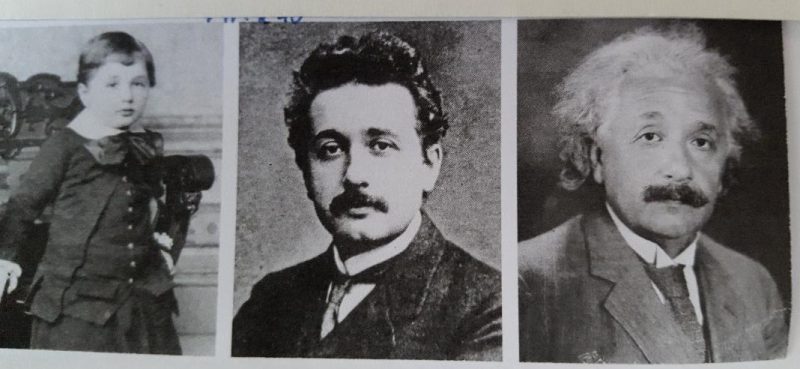Albert Einstein, the iconic physicist of the twentieth century, was born at a time when prevailing physical science was deemed inadequate and incapable of explaining emerging scientific evidence and, worst of all, there was nothing in the horizon to replace it. The scientific establishment of the day was complacent with this impasse. When Max Planck, the future pioneer of quantum concept, approached his professor in Munich in 1879 at the age of 21 and expressed his desire to pursue a career in physics, he was told by the patronising professor that ‘it is hardly worth entering physics anymore’ because there was nothing important left to discover!
Albert Einstein, an Ashkenazi Jew (secular in religious outlook), was born on Friday, 14 March 1879 in the historic city of Ulm, Kingdom of Wurttemberg, in the then German Empire. His father, being an engineer and a salesman, gave little Einstein every encouragement and adequate technical backing to pursue a technical career. He was very inquisitive and tenacious. Nothing he would consider as unattainable. As a child he wondered if he could ride on a beam of light! He said about himself years later, “God gave me the stubbornness of a mule.”
As a child he was not a prodigy by any means. As a strong headed boy, he intensely disliked strict disciplinarian life, either at school or at home. But he would pursue his curiosity, his objective with passion and energy. Years later, he said, “Learn from yesterday, live for today, hope for tomorrow. The important thing is not to stop questioning.”
At the age of nine, when he was sent by his parents to Luitpold Gymnasium (a strict discipline focussed school) in Munich, he was not happy at all. He intensely disliked ‘rote learning’ method at the school with no opportunity for creative thinking. However, he pursued his studies there until the age 16 (1895) to keep parents happy. But then to avoid compulsory military service in Germany, he left the school, went to his parents in Italy at the end of 1895. After spending few months with his parents in Italy, he was persuaded by his parents to continue with his secondary education in science at a Cantonal school in Zurich, Switzerland. He renounced his German citizenship in 1896, so that he would never be called for military service in Germany. He completed his studies and then graduated with a teaching diploma in physics and mathematics in 1900. All these years, from 1895 to 1900, he was stateless. He acquired Swiss citizenship in 1901 after completing five years of residence there.
Aspiring to take up a career in physics, particularly at a university, at that time was not easy. He scaled down his ambition and for nearly two years, he even tried to get a school teaching post, but without success. Eventually on the recommendation of the father of his close friend, he managed to get a humble position at the Swiss Patent Office in Bern, capital of Switzerland, in 1902 as a ‘Technical Expert – Third Class.’ Although the position was lowly, but the salary was quite handsome. This job, according to him, brought an end to ‘the annoying business of starving.’
He moved to Bern in 1902 and lived there until 1907. Initially, as a bachelor, he rented a room beyond the river Aare, which meanders across the capital city of Bern. After he got married in 1903, he rented a two-bedroom apartment on the second floor of 49 Kramgasse at the picturesque Old Town part of Bern. The cobbled street of Kramgasse, with the famous clock tower on one side and the river Aare, some three hundred meters away (about two hundred meters from 49 Kramgasse) on the other, was one of the most beautiful streets in Bern. At the end of Kramgasse, a historic bridge led to the other side of the river. From the street level, a series of steps, some 200 of them, led to the river banks. Einstein used to sit and contemplate by the river in summer evenings as the rippling sound of crystal clear water cascaded down the shallow river.
Einstein used to leave his apartment just before eight o’clock in the morning for a 10-minute walk to the imposing Patent Office building. He said later in his life that his work as a Patent Clerk was only for 48 hour a week, and he had one additional day to spare! At work he had to look at the design details of electrical devices submitted by budding inventors. This required him to scrutinise details and identify any possible flaws. These traits and critical thinking honed his talent for future research in physics.
What inspired Einstein to write his first ground breaking paper in 1905 advancing the proposal on the quantum theory of light was Max Planck’s paper detailing the solution of the blackbody problem with an outline of hitherto unheard of quantum concept of emission and absorption of light a few years back. Einstein read the paper and was completely overwhelmed by this radical concept of Max Planck. Einstein carried forward that quantum idea and produced a paper on photoelectric effects of light with the title ‘On a Heuristic Point of View Concerning the Production and Transformation of Light’ for the journal ‘Annalen der Physik.’ world’s leading physics journal in Germany, and posted it on 17 March 1905. Max Planck happened to be the adviser on theoretical physics to that journal at that time. Despite Planck’s reservation with Einstein’s mind-boggling concept of particulate nature of light, sweeping away age-old concept of wave nature of light, he allowed the paper to be published simply because of its radical nature.
 Einstein produced altogether four papers between this date of 17 of March and 30 of July,1905. The second one was from his Ph.D. dissertation where he set out a way of determining the sizes of atoms. The third one was the explanation of Brownian motion of atoms and molecules. The fourth one was, as Einstein himself admitted, a rough draft on ‘On the Electrodynamics of Moving Bodies’ giving details of the concepts of space and time. Max Planck read all of these papers, but when he read the last paper, he was simply blown away. Although Einstein did not call it ‘the theory of relativity,’ Max Planck called it so and the title stuck with it ever since.
Einstein produced altogether four papers between this date of 17 of March and 30 of July,1905. The second one was from his Ph.D. dissertation where he set out a way of determining the sizes of atoms. The third one was the explanation of Brownian motion of atoms and molecules. The fourth one was, as Einstein himself admitted, a rough draft on ‘On the Electrodynamics of Moving Bodies’ giving details of the concepts of space and time. Max Planck read all of these papers, but when he read the last paper, he was simply blown away. Although Einstein did not call it ‘the theory of relativity,’ Max Planck called it so and the title stuck with it ever since.
Before the year was over, Einstein produced another paper, which contained a small equation, E = mc2 (actually the equation was E= mc2/(√(1-q2/c2) where q was the speed of the body and c was the speed of light. If q was much smaller than c, then the term inside the square root became very close to 1 and hence E = mc2). This equation came to be known as the mass-energy equivalence with which Einstein became synonymous. Also, during the same year, he reviewed as many as 21 technical books for this Annalen der Physik journal!
No other scientist, except Isaac Newton, had ever produced as many ground breaking monumental papers in such quick succession as Einstein did in 1905. He was only 26 at that time. Isaac Newton, an Englishman, at the age of 23 produced the gravitational law and advanced the theory of light, all in 1666! Oh, he also laid the foundation for calculus in the same year! It is amazing to note that these two prodigal physicists dealt with the same physical problems – theory of gravity and theory of light – with incredible ingenuity.
Einstein received Nobel Prize in Physics in 1921 for his work on photoelectric effects of light. His work on special theory of relativity (followed by general theory of relativity in 1916) could also have warranted another Nobel Prize, but the concept was so profound and radical that even the Nobel Committee found it challenging without any supporting evidence! His mass-energy equivalence could have been another candidate for Nobel Prize. He laid foundations of two major planks of modern physics – quantum mechanics and theory of relativity, all in a single year of 1905!
Dr Anisur Rahman; CRadP, MSRP, FNucl; is now a retired nuclear physicist / nuclear safety specialist. He is the author of a graduate/post-graduate text book entitled ‘Decommissioning and Radioactive Waste Management.’ He lives in the UK.
Original Publication Reference Link:
https://provakar.net/2018/02/12/einsteins-incredible-burst-of-creativity-in-1905/
http://visioncreatesvalue.blogspot.com/












Leave a comment